The Cambridge History of Japan, Vol. 1: Ancient Japan
Подождите немного. Документ загружается.


CHAPTER 6
EARLY KAMI WORSHIP
From prehistoric times the Japanese have revered animistic spirits and
deities called kami. Eventually the worship of kami developed into a
religious system known as Shinto or "the kami way." The two Chinese
characters used in Japan for writing "Shinto" had been used for centu-
ries in China to refer to the supernatural or the mysterious. Adopted in
Japan at the end of the sixth century A.D., these characters were em-
ployed to distinguish native kami worship from Buddhism (the Bud-
dha way), recently imported from the Asian continent. Early sources
suggest that Shinto was then synonomous with the old word
kamuna-
gara, which denoted a "way" handed down by the kami themselves
without human revision.
By the time that Japan's native religion was identified as Shinto,
kami worship had moved beyond awe of natural forces to institutional-
ized rituals believed to ensure protection and prosperity for the clans
(uji),
and to provide religious sanction for the clan chieftains and
territorial rulers. This chapter will therefore be devoted mainly to
showing how kami beliefs and practices, while retaining their ani-
mistic core, moved from simple to complex forms.
GENERAL PROBLEMS
The
concept
of kami
The standard translation of kami is "deity," a word suggesting the
Western concept of a transcendental divinity such as in the Judaeo-
Christian God. But the gulf between divinity and humanity found in
the Judaic religions does not exist in Shinto. Even though the Shinto
kami are given credit for creating various parts of the universe, kami
are neither omniscient nor omnipotent, and unlike the ancient Greek
gods,
they are not necessarily immortal.
The classic definition of kami is the one advanced by Motoori
317
Cambridge Histories Online © Cambridge University Press, 2008

3l8 EARLY KAMI WORSHIP
Norinaga (1730-1801),
a
distinguished scholar of Japanese history and
literature:
Kami are, first of all, deities of heaven and earth and spirits venerated at
shrines,
as well
as the
humans,
birds and
beasts,
plants and
trees,
oceans,
and
mountains that have exceptional powers and ought to be revered. Kami
include not only mysterious beings that are noble and good but also malig-
nant spirits that are extraordinary and deserve veneration.
1
Western scholars of Shinto tend to accept Motoori's definition: F. H.
Ross wrote that kami are mysterious beings associated with feelings of
"awesomeness" and "the holy,"
2
and A. C. Underwood defined kami
as including all supernatural beings, good or bad.3
In general, the Japanese believed that any extraordinary phenome-
non possessed charismatic power. That is, the spirit of a kami might
reside in heavenly bodies such as the sun, moon, and stars or in the
forces of nature such as wind, rain, and lightning. Thunder, for in-
stance, was called "the kami that rumbles." Striking topographical
features such as oceans, rivers, and mountains, or even manufactured
objects (buildings, boats, combs, or hearths) might house a kami. A
charismatic ruler or aristocrat was often named a kami, and certain
animals were known as kami, such as tigers, wolves, hares, and ser-
pents,
if they were exceptional for their species. An ancient myth even
tells of a peach seed with the power to repel evil demons and names the
seed Okamutsumi (the "great kami seed"). The charisma that a kami
possesses resembles
mana,
the extraordinary power that the people of
Melanesia associate with supernatural phenomena or fearsome objects.
Although some spirits were honored and feared by the ancient Japa-
nese and called kami, many were given other names with subtle differ-
1 Motoori Norinaga, Kojikiden pt. i, chap. 3, vol. 9 of Motoori Norinaga zenshu (Tokyo:
Chikuma shobo, 1976), p. 125.
2 Floyd Hiatt Ross, Shinto: The
Way
of Japan (Boston: Beacon Press, 1965), p. 32.
3 A. C. Underwood, Shintdism:
The Indigenous
Religion of Japan (London: Beacon Press, 1965),
p.
32. Other Western scholars have grappled with the essential nature of kami belief and
worship: see D. C. Holtom, "The Meaning of Kami,"
Monumenta
Nipponica 3, no. 1 (1940):
1-27; 3, no. 2 (1940): 392-413; and 4, no. 2 (1942): 351-94; Richard Arthur Brabazon
Ponsonby-Fane, The Vicissitudes of Shinto (Kyoto: Ponsonby Memorial Society, 1963); and
Jean Herbert, Shinto: At the
Fountain-Head
of Japan (New York: Stein & Day, 1967). Studies
by two distinguished Japanese scholars of Shinto have been translated into English: Tsune-
tsugu Muraoka, Studies in Shinto Thought, trans. Delmer M. Brown and James T. Araki
(Tokyo: Ministry of Education, 1964); and Genichi Kato, A Historical Study of
the
Religious
Development of Shinto, trans. Shoyu Hanayama (Tokyo: Ministry of Education, 1973). Other
Western works on Shinto are listed in Genichi Kato, Karl Reitz, and Wilhelm Schiffer,
comps., A Bibliography of Shinto
in Western
Languages, from the Oldest
Times
till 1952 (Tokyo:
Meiji jingu shamusho, 1953); and in Arcadio Schwade, Shinto Bibliography in
Western
Lan-
guages:
Bibliography
on
Shinto and
Religious
Sects, Intellectual
Schools
and
Movements Influenced
by Shintdism (Leiden: Brill, 1986).
Cambridge Histories Online © Cambridge University Press, 2008

GENERAL PROBLEMS 319
ences in meaning. There were
tama
(souls),
mono
(demons),
tsuchi
and
mi (animistic spirits), and chi and itsu (spirits that possessed magical
powers). Kami were chosen from that crowd of spirits, elevated in
rank, further sanctified, and later anthropomorphized. The kami of
the mountains, for instance, were thought to control the spirits, ani-
mals,
and plants in a specific mountain region, and the kami of the
ocean to control ocean life. In a later stage of development, such kami
were often given names and selected as tutelary deities by important
clans.
The Ochi clan of Shikoku's Iyo Province (present-day Ehime
Prefecture) adopted a mountain kami as its tutelary deity (ujigami),
and an ocean kami was taken as the
ujigami
of the Azumi clan based in
the seacoast province of Chikuzen (Fukuoka Prefecture).
Finally, the most important kami often possessed the power
to
create.
Though there is no equivalent in Shinto to the Judaic God's creation of
the cosmos and everything in it, kami did give birth to familiar portions
of
the
universe. Myths tell us, for instance, that the husband and wife
kami, Izanagi and Izanami, created the islands of
Japan.*
Moreover, the
word
tnusubi
attached to the names of many kami - the high-ranking
Takamimusubi is one important example - connotes creative power.
Creator and life-giving kami such as Izanagi, Izanami, Takamimusubi,
and Amaterasu (the Sun Goddess who became the ancestral kami of the
imperial clan) all occupied high positions in the "myriad kami" pan-
theon appearing in Japan's earliest recorded myths.
Ethics and ritual purity
The ethical content of Shinto is weak in comparison with that of such
universalistic religions as Christianity and Buddhism. Shinto stresses
ritual purity rather than ethics and morality, and Shinto rituals are
designed to counteract ritual pollution. The word
tsumi
indicates an
offense or pollution that must be neutralized by ritual cleansing. The
concept of
tsumi
also differs from the Christian concept of original sin,
an
evil
inherent in human nature and one that can be purged only by con-
fessing to God and receiving his forgiveness. The Shinto concept also
differs from the "carnal passions" that obstruct one's understanding
and acceptance of Buddhist truth.
Tsumi,
moreover, were not believed
4 Kojiki, bk. 1 in Sakamoto Taro, Ienaga Saburo, Inoue Mitsusada, and Ono Susumu, eds.,
Nihon
koten
bungaku laikei (hereafter cited as NK.BT) (Tokyo: Iwanami shoten, 1967), vol. 1,
pp.
54-57; trans. Donald L. Philippi, Kojiki (Tokyo: University of Tokyo Press, 1968), pp.
49> 53-54- Nihon shoki, bk. 1, NKBT 67.81-90, trans. W. G. Aston, Nihongi:
Chronicles
of
japan
from
the Earliest Times to
A.D.
697 (hereafter cited as Aston) (London: Allen & Unwin,
1956),
pt. 1, pp. 12-18.
Cambridge Histories Online © Cambridge University Press, 2008
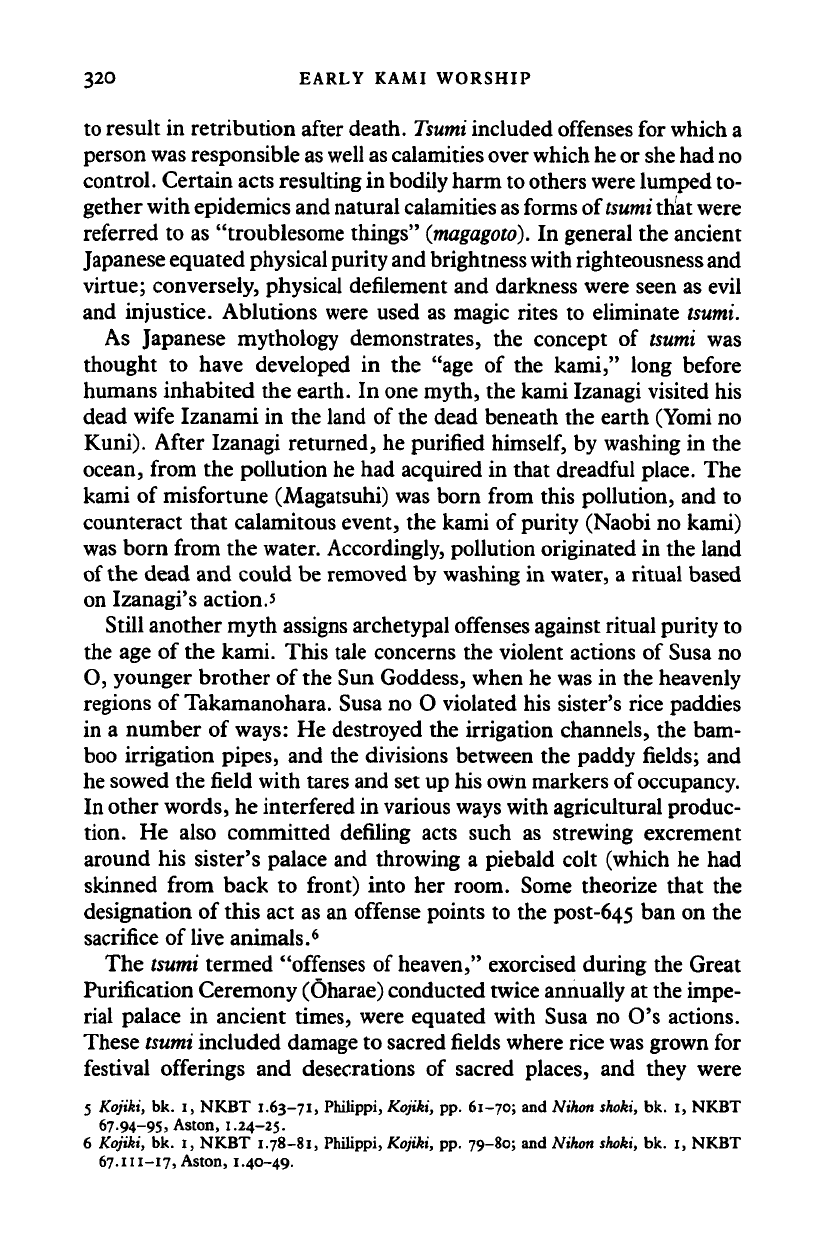
320 EARLY KAMI WORSHIP
to result in retribution after death.
Tsumi
included offenses for which a
person was responsible as well as calamities over which he or she had no
control. Certain acts resulting in bodily harm to others were lumped to-
gether with epidemics and natural calamities as forms of tsumi that were
referred to as "troublesome things"
(magagoto).
In general the ancient
Japanese equated physical purity and brightness with righteousness and
virtue; conversely, physical defilement and darkness were seen as evil
and injustice. Ablutions were used as magic rites to eliminate tsumi.
As Japanese mythology demonstrates, the concept of tsumi was
thought to have developed in the "age of the kami," long before
humans inhabited the earth. In one myth, the kami Izanagi visited his
dead wife Izanami in the land of the dead beneath the earth (Yomi no
Kuni).
After Izanagi returned, he purified
himself,
by washing in the
ocean, from the pollution he had acquired in that dreadful place. The
kami of misfortune (Magatsuhi) was born from this pollution, and to
counteract that calamitous event, the kami of purity (Naobi no kami)
was born from the water. Accordingly, pollution originated in the land
of the dead and could be removed by washing in water, a ritual based
on Izanagi's action.5
Still another myth assigns archetypal offenses against ritual purity to
the age of the kami. This tale concerns the violent actions of Susa no
O, younger brother of the Sun Goddess, when he was in the heavenly
regions of Takamanohara. Susa no O violated his sister's rice paddies
in a number of
ways:
He destroyed the irrigation channels, the bam-
boo irrigation pipes, and the divisions between the paddy fields; and
he sowed the field with tares and set up his own markers of occupancy.
In other words, he interfered in various ways with agricultural produc-
tion. He also committed defiling acts such as strewing excrement
around his sister's palace and throwing a piebald colt (which he had
skinned from back to front) into her room. Some theorize that the
designation of this act as an offense points to the post-645 ban on the
sacrifice of live animals.
6
The
tsumi
termed "offenses of heaven," exorcised during the Great
Purification Ceremony (Oharae) conducted twice annually at the impe-
rial palace in ancient times, were equated with Susa no O's actions.
These
tsumi
included damage to sacred fields where rice was grown for
festival offerings and desecrations of sacred places, and they were
5 Kojiki, bk. 1, NKBT 1.63-71, Philippi, Kojiki, pp. 61-70; and Nihon shoki, bk. 1, NKBT
67-94-95* Aston, 1.24-25.
6 Kojiki, bk. I, NKBT 1.78-81, Philippi, Kojiki, pp. 79-80; and Nihon shoki, bk. 1, NKBT
67.111-17, Aston, 1.40-49.
Cambridge Histories Online © Cambridge University Press, 2008
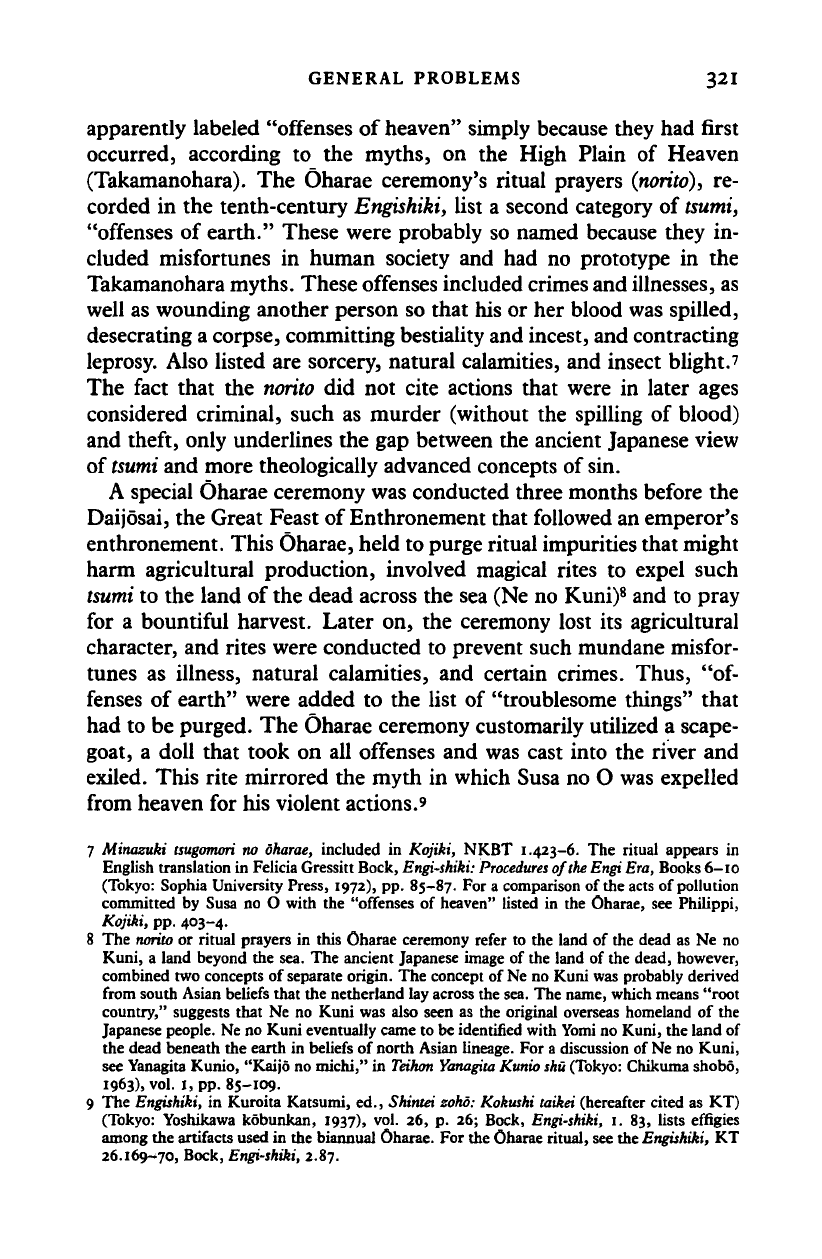
GENERAL PROBLEMS 321
apparently labeled "offenses of heaven" simply because they had first
occurred, according to the myths, on the High Plain of Heaven
(Takamanohara). The Oharae ceremony's ritual prayers
(norito),
re-
corded in the tenth-century
Engishiki,
list a second category of
tsumi,
"offenses of earth." These were probably so named because they in-
cluded misfortunes in human society and had no prototype in the
Takamanohara
myths.
These offenses included crimes and illnesses, as
well as wounding another person so that his or her blood was spilled,
desecrating a corpse, committing bestiality and incest, and contracting
leprosy. Also listed are sorcery, natural calamities, and insect blight.
7
The fact that the
norito
did not cite actions that were in later ages
considered criminal, such as murder (without the spilling of blood)
and theft, only underlines the gap between the ancient Japanese view
of
tsumi
and more theologically advanced concepts of sin.
A special Oharae ceremony was conducted three months before the
Daijosai, the Great Feast of Enthronement that followed an emperor's
enthronement. This Oharae, held to purge ritual impurities that might
harm agricultural production, involved magical rites to expel such
tsumi
to the land of the dead across the sea (Ne no Kuni)
8
and to pray
for a bountiful harvest. Later on, the ceremony lost its agricultural
character, and rites were conducted to prevent such mundane misfor-
tunes as illness, natural calamities, and certain crimes. Thus, "of-
fenses of earth" were added to the list of "troublesome things" that
had to be purged. The Oharae ceremony customarily utilized a scape-
goat, a doll that took on all offenses and was cast into the river and
exiled. This rite mirrored the myth in which Susa no O was expelled
from heaven for his violent actions.
9
7 Minazuki
tsugomori
no
oharae,
included in Kojiki, NKBT
1.423-6.
The ritual appears in
English translation in Felicia Gressitt Bock, Engishiki:
Procedures
of
the Engi
Era,
Books 6-10
(Tokyo: Sophia University Press, 1972), pp. 85-87. For a comparison of the acts of pollution
committed by Susa no O with the "offenses of heaven" listed in the Oharae, see Philippi,
Kojiki, pp. 403-4.
8 The
norito
or ritual prayers in this Oharae ceremony refer to the land of the dead as Ne no
Kuni, a land beyond the sea. The ancient Japanese image of the land of the dead, however,
combined two concepts of separate origin. The concept of Ne no Kuni was probably derived
from south Asian beliefs that the netberland lay across the sea. The name, which means "root
country," suggests that Ne no Kuni was also seen as the original overseas homeland of the
Japanese people. Ne no Kuni eventually came to be identified with Yomi no Kuni, the land of
the dead beneath the earth in beliefs of north Asian lineage. For a discussion of Ne no Kuni,
see Yanagita Kunio, "Kaijo no michi," in
Teihon Yanagita Kunio shu
(Tokyo:
Chikuma shobo,
1963),
vol. 1, pp. 85-109.
9 The
Engishiki,
in Kuroita Katsumi, ed.,
Shintei
zoho:
Kokushi taikei
(hereafter cited as KT)
(Tokyo: Yosnikawa kobunkan, 1937), vol. 26, p. 26; Bock, Engishiki, 1. 83, lists effigies
among the artifacts used in the biannual Oharae. For the Oharae ritual, see the
Engishiki,
KT
26.169-70, Bock, Engishiki, 2.87.
Cambridge Histories Online © Cambridge University Press, 2008

322 EARLY KAMI WORSHIP
The common element that links all
tsumi is
their danger to the cosmic
and social order.
10
The primitive Japanese believed that society and the
cosmos were interrelated and that disturbing one could disturb the
other. As violations of the normal order of things,
tsumi
were to be
feared because it
was
thought that they would invite
calamity.
Improper
sexual relations, for instance, might lead to poor harvests. Thus rules
for conduct were not based on principles considered inherently moral,
and the danger caused by improper actions or unfortunate events might
be removed completely by conducting the appropriate magical rites.
Shinto literature and the
structure
of Shinto mythology
Various literary and historical works of the eighth to the tenth centu-
ries provide considerable information about Shinto practices and the
development of Shinto mythology. Particularly useful texts include the
semihistorical chronicles Kojiki (712) and Nihon
shoki
(720), compiled
under the auspices of the imperial court; fudoki, provincial gazetteers
also compiled under imperial orders; the Kotai jingu
gishikicho
and
Toyuke
no miya
gishikicho
(804), records of the Grand Shrine at Ise;
Imbe no Hironari's
Kogoshui
(807), which records the history and
traditions of his family; and the Engishiki (Procedures of the Engi
period, 927) which includes ceremonial prayers
(norito),
descriptions
of imperial rites, and records of officially sanctioned shrines."
Shinto mythology is described most systematically in the "age of the
kami" chapters of the Kojiki and Nihon
shoki,
chronicles compiled to
justify the efforts of one powerful clan, based on the Yamato plain of
central Honshu, to extend its rule over Japan and call itself the impe-
rial clan. The Kojiki, in particular, takes hitherto unrelated myths and
weaves them into a narrative tale that moves directly from the creation
of the universe to the creation of the imperial house. This neat sequen-
tial arrangement suggests manipulation for political purposes. Indeed,
political rather than ethical or theological concepts lie at the core of
10 This hypothesis is advanced by Obayashi Taryo, "Kodai Nihon ni okeru bunrui no ronri," in
Obayashi Taryo, ed., Shinwa, shakai, sekaikan (Tokyo: Kadokawa shoten, 1972), pp. 329-
56;
and Matsumae Takeshi, "Shizoku shakai no shiso," in Furukawa Tetsushi and Ishida
Ichiro, eds., in vol. 1 of Nihon
shisoshi
koza (Tokyo: Yuzankaku, 1977), pp. 7-26.
11 Fudoki, NKBT, vol. 2, trans. Michiko Yamaguchi Aoki, Izumo fudoki
(Tokyo:
Sophia Univer-
sity Press, 1971); "Kotai jingu gishikicho," in Hanawa Hokinoichi, ed., Gunshoruiju (Tokyo:
Keizai zasshisha, 1898), vol. 1, pp. 1—51; Onakatomi no Matsugu et al., eds., "Toyuke-gu
gishiki cho," in Gunsho ruiju, 1.52-83; Imbe no Hironari, ed., "Kogoshui," in
Gunsho
ruiju,
16.1-19, trans. Genchi Kato and Hikoshiro Hoshino, Kogoshui: Gleanings
from
Ancient Sto-
ries (London: Curzon Press, and New York: Barnes & Noble, 1972, reproduction of 1926
ed.).
Cambridge Histories Online © Cambridge University Press, 2008
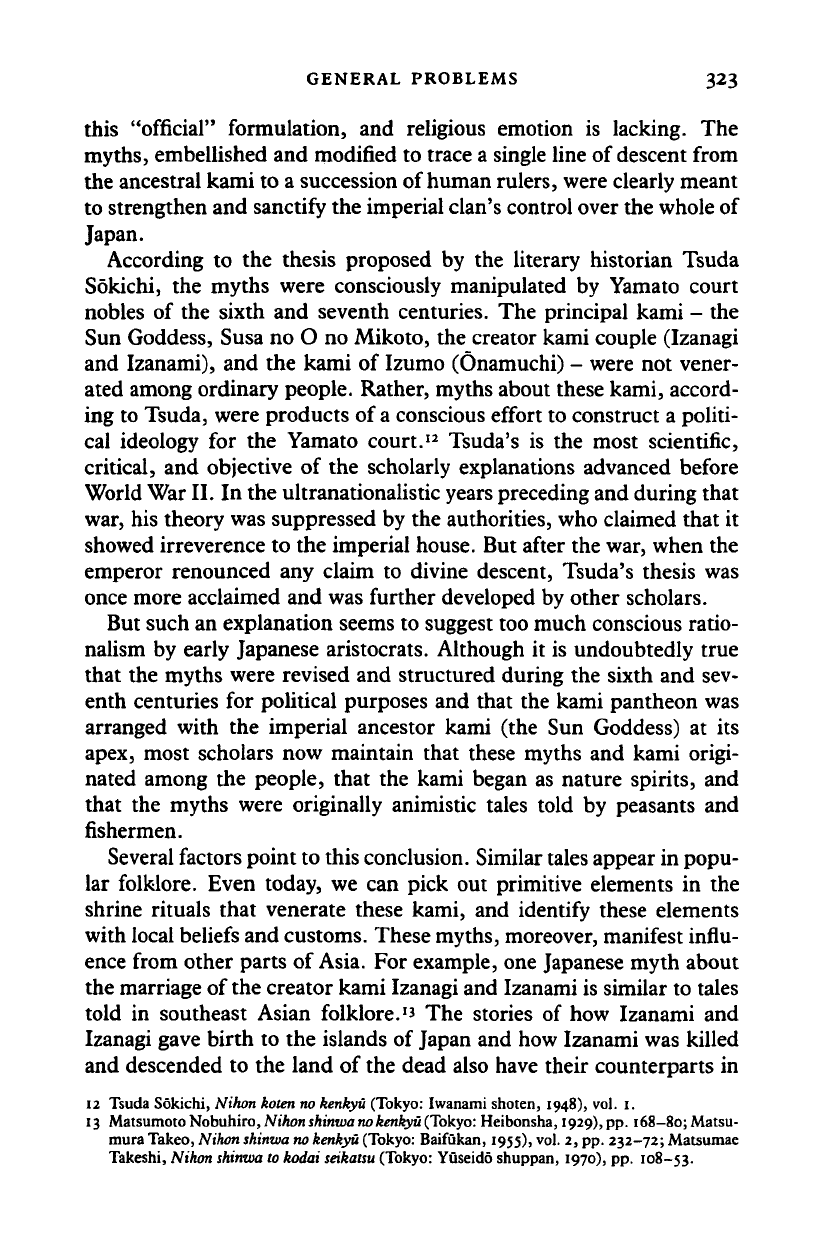
GENERAL PROBLEMS 323
this "official" formulation, and religious emotion is lacking. The
myths, embellished and modified to trace a single line of descent from
the ancestral kami to a succession of human rulers, were clearly meant
to strengthen and sanctify the imperial clan's control over the whole of
Japan.
According to the thesis proposed by the literary historian Tsuda
Sokichi, the myths were consciously manipulated by Yamato court
nobles of the sixth and seventh centuries. The principal kami - the
Sun Goddess, Susa no O no Mikoto, the creator kami couple (Izanagi
and Izanami), and the kami of Izumo (Onamuchi) - were not vener-
ated among ordinary people. Rather, myths about these kami, accord-
ing to Tsuda, were products of
a
conscious effort to construct a politi-
cal ideology for the Yamato court.
12
Tsuda's is the most scientific,
critical, and objective of the scholarly explanations advanced before
World War II. In the ultranationalistic years preceding and during that
war, his theory was suppressed by the authorities, who claimed that it
showed irreverence to the imperial house. But after the war, when the
emperor renounced any claim to divine descent, Tsuda's thesis was
once more acclaimed and was further developed by other scholars.
But such an explanation seems to suggest too much conscious ratio-
nalism by early Japanese aristocrats. Although it is undoubtedly true
that the myths were revised and structured during the sixth and sev-
enth centuries for political purposes and that the kami pantheon was
arranged with the imperial ancestor kami (the Sun Goddess) at its
apex, most scholars now maintain that these myths and kami origi-
nated among the people, that the kami began as nature spirits, and
that the myths were originally animistic tales told by peasants and
fishermen.
Several factors point to this conclusion. Similar tales appear in popu-
lar folklore. Even today, we can pick out primitive elements in the
shrine rituals that venerate these kami, and identify these elements
with local beliefs and customs. These myths, moreover, manifest influ-
ence from other parts of
Asia.
For example, one Japanese myth about
the marriage of the creator kami Izanagi and Izanami is similar to tales
told in southeast Asian folklore. "3 The stories of how Izanami and
Izanagi gave birth to the islands of Japan and how Izanami was killed
and descended to the land of the dead also have their counterparts in
12 Tsuda Sokichi, Nihon koten no kenkyu (Tokyo: Iwanami shoten, 1948), vol. 1.
13 Matsumoto Nobuhiro, Nihon shinwa
no kenkyu
(Tokyo:
Heibonsha, 1929), pp. 168-80; Matsu-
mura Takeo, Nihon shinwa
no kenkyu
(Tokyo: Baifukan, 1955), vol. 2, pp. 232-72; Matsumae
Takeshi, Nikon shinwa to kodai
seikatsu
(Tokyo: Yuseido shuppan, 1970), pp. 108-53.
Cambridge Histories Online © Cambridge University Press, 2008
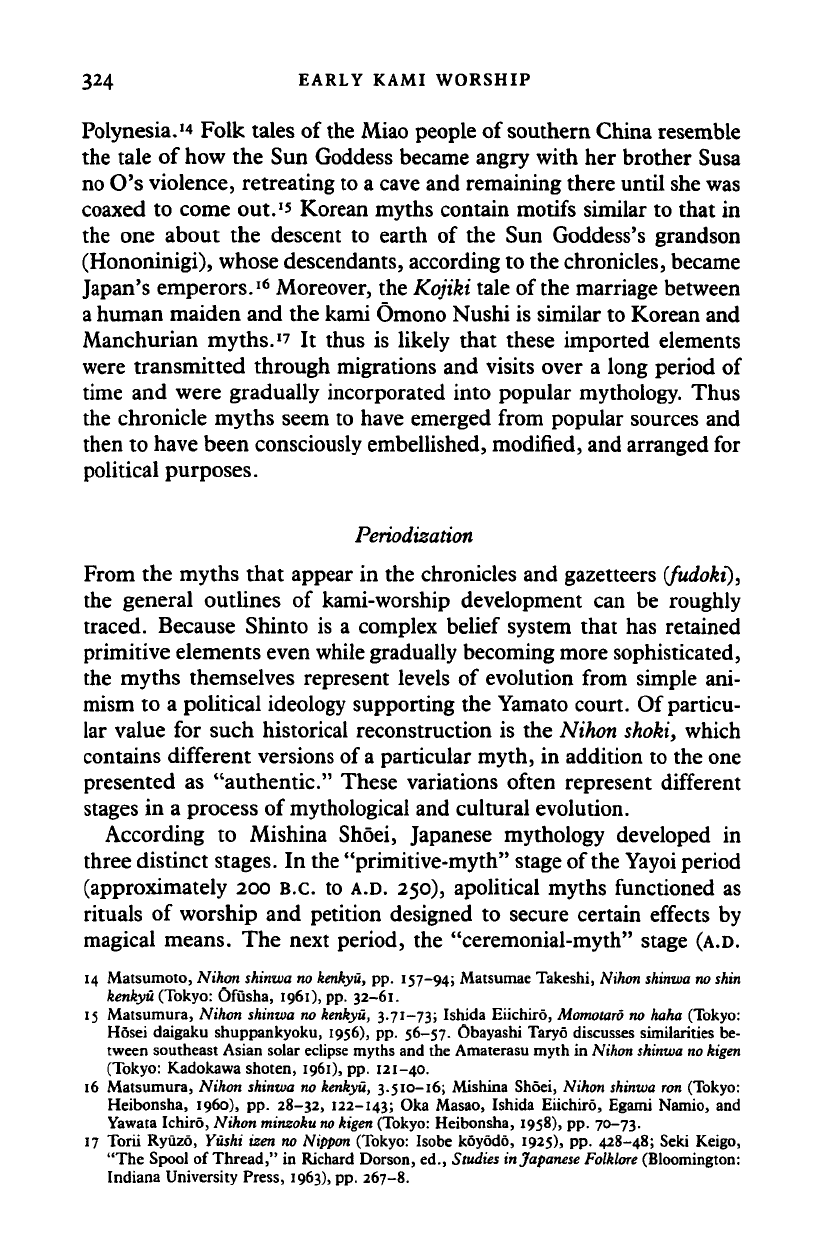
324 EARLY KAMI WORSHIP
Polynesia.
11
* Folk tales of the Miao people of southern China resemble
the tale of how the Sun Goddess became angry with her brother Susa
no O's violence, retreating to a cave and remaining there until she was
coaxed to come out.'s Korean myths contain motifs similar to that in
the one about the descent to earth of the Sun Goddess's grandson
(Hononinigi), whose descendants, according to the chronicles, became
Japan's emperors.
16
Moreover, the Kojiki tale of the marriage between
a human maiden and the kami Omono Nushi is similar to Korean and
Manchurian myths.
17
It thus is likely that these imported elements
were transmitted through migrations and visits over a long period of
time and were gradually incorporated into popular mythology. Thus
the chronicle myths seem to have emerged from popular sources and
then to have been consciously embellished, modified, and arranged for
political purposes.
Periodization
From the myths that appear in the chronicles and gazetteers (fudoki),
the general outlines of kami-worship development can be roughly
traced. Because Shinto is a complex belief system that has retained
primitive elements even while gradually becoming more sophisticated,
the myths themselves represent levels of evolution from simple ani-
mism to a political ideology supporting the Yamato court. Of particu-
lar value for such historical reconstruction is the Nihon
shoki,
which
contains different versions of
a
particular myth, in addition to the one
presented as "authentic." These variations often represent different
stages in a process of mythological and cultural evolution.
According to Mishina Shoei, Japanese mythology developed in
three distinct stages. In the "primitive-myth" stage of the Yayoi period
(approximately 200 B.C. to
A.D.
250), apolitical myths functioned as
rituals of worship and petition designed to secure certain effects by
magical means. The next period, the "ceremonial-myth" stage
(A.D.
14 Matsumoto, Nihon shinwa no
kenkyu,
pp. 157-94; Matsumae Takeshi, Nihon shinwa no shin
kenkyu (Tokyo: Ofusha, 1961), pp.
32-61.
15 Matsumura, Nihon shinwa no
kenkyu,
3.71-73; Ishida Eiichiro, Momolaw no haha (Tokyo:
Hosei daigaku shuppankyoku, 1956), pp. 56-57. Obayashi Taryo discusses similarities be-
tween southeast Asian solar eclipse myths and the Amaterasu myth in Nihon shinwa
no kigen
(Tokyo: Kadokawa shoten, 1961), pp. 121-40.
16 Matsumura, Nihon shinwa no kenkyu, 3.510-16; Mishina Shoei, Nihon shinwa ton (Tokyo:
Heibonsha, i960), pp. 28-32, 122-143; Oka Masao, Ishida Eiichiro, Egami Namio, and
Yawata Ichiro, Nihon minzoku
no kigen
(Tokyo: Heibonsha, 1958), pp. 70-73.
17 Torii Ryuzo, Yushi izen no Nippon (Tokyo: Isobe koyodo, 1925), pp. 428-48; Seki Keigo,
"The Spool of Thread," in Richard Dorson, ed., Studies
in
Japanese
Folklore
(Bloomington:
Indiana University Press, 1963), pp. 267-8.
Cambridge Histories Online © Cambridge University Press, 2008
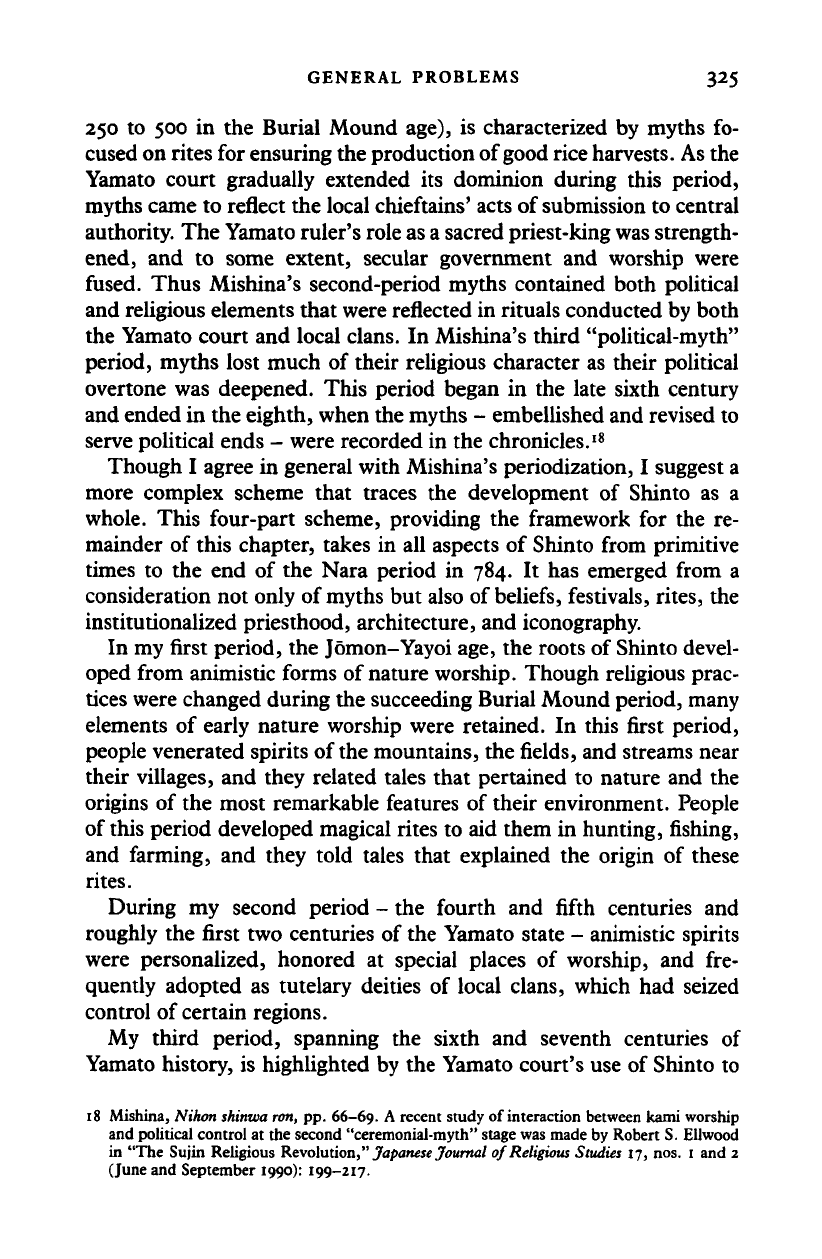
GENERAL PROBLEMS 325
250 to 500 in the Burial Mound age), is characterized by myths fo-
cused on rites for ensuring the production of good rice
harvests.
As the
Yamato court gradually extended its dominion during this period,
myths came to reflect the local chieftains' acts of submission to central
authority. The Yamato ruler's role as
a
sacred priest-king was strength-
ened, and to some extent, secular government and worship were
fused. Thus Mishina's second-period myths contained both political
and religious elements that were reflected in rituals conducted by both
the Yamato court and local clans. In Mishina's third "political-myth"
period, myths lost much of their religious character as their political
overtone was deepened. This period began in the late sixth century
and ended in the eighth, when the myths - embellished and revised to
serve political ends - were recorded in the chronicles.
18
Though I agree in general with Mishina's periodization, I suggest a
more complex scheme that traces the development of Shinto as a
whole. This four-part scheme, providing the framework for the re-
mainder of this chapter, takes in all aspects of Shinto from primitive
times to the end of the Nara period in 784. It has emerged from a
consideration not only of myths but also of beliefs, festivals, rites, the
institutionalized priesthood, architecture, and iconography.
In my first period, the Jomon-Yayoi age, the roots of Shinto devel-
oped from animistic forms of nature worship. Though religious prac-
tices were changed during the succeeding Burial Mound period, many
elements of early nature worship were retained. In this first period,
people venerated spirits of the mountains, the fields, and streams near
their villages, and they related tales that pertained to nature and the
origins of the most remarkable features of their environment. People
of this period developed magical rites to aid them in hunting, fishing,
and farming, and they told tales that explained the origin of these
rites.
During my second period - the fourth and fifth centuries and
roughly the first two centuries of the Yamato state - animistic spirits
were personalized, honored at special places of worship, and fre-
quently adopted as tutelary deities of local clans, which had seized
control of certain regions.
My third period, spanning the sixth and seventh centuries of
Yamato history, is highlighted by the Yamato court's use of Shinto to
18 Mishina, Nihon shinwa ron, pp. 66-69. A recent study of interaction between kami worship
and political control at the second "ceremonial-myth" stage was made by Robert S. Ellwood
in "The Sujin Religious Revolution,"
Japanese Journal
of Religious Studies 17, nos. 1 and 2
(June and September 1990): 199-217.
Cambridge Histories Online © Cambridge University Press, 2008
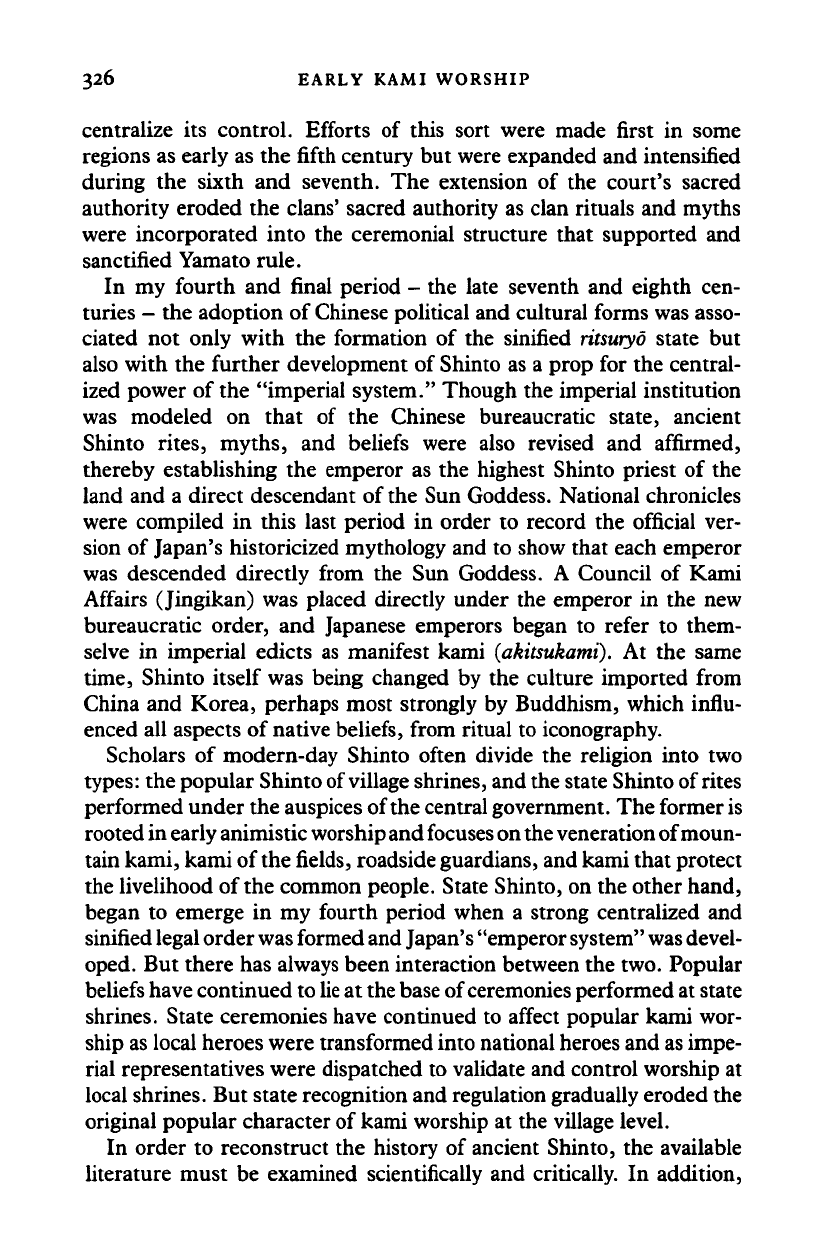
326 EARLY KAMI WORSHIP
centralize its control. Efforts of this sort were made first in some
regions as early as the fifth century but were expanded and intensified
during the sixth and seventh. The extension of the court's sacred
authority eroded the clans' sacred authority as clan rituals and myths
were incorporated into the ceremonial structure that supported and
sanctified Yamato rule.
In my fourth and final period - the late seventh and eighth cen-
turies - the adoption of Chinese political and cultural forms was asso-
ciated not only with the formation of the sinified
ritsuryo
state but
also with the further development of Shinto as a prop for the central-
ized power of the "imperial system." Though the imperial institution
was modeled on that of the Chinese bureaucratic state, ancient
Shinto rites, myths, and beliefs were also revised and affirmed,
thereby establishing the emperor as the highest Shinto priest of the
land and a direct descendant of the Sun Goddess. National chronicles
were compiled in this last period in order to record the official ver-
sion of Japan's historicized mythology and to show that each emperor
was descended directly from the Sun Goddess. A Council of Kami
Affairs (Jingikan) was placed directly under the emperor in the new
bureaucratic order, and Japanese emperors began to refer to them-
selve in imperial edicts as manifest kami
(akitsukami).
At the same
time,
Shinto itself was being changed by the culture imported from
China and Korea, perhaps most strongly by Buddhism, which influ-
enced all aspects of native beliefs, from ritual to iconography.
Scholars of modern-day Shinto often divide the religion into two
types:
the popular Shinto of village shrines, and the state Shinto of rites
performed under the auspices of the central government. The former
is
rooted in early animistic worship and focuses on the veneration of moun-
tain kami, kami of the
fields,
roadside guardians, and kami that protect
the livelihood of the common people. State Shinto, on the other hand,
began to emerge in my fourth period when a strong centralized and
sinified legal order
was
formed and Japan's "emperor
system"
was devel-
oped. But there has always been interaction between the two. Popular
beliefs have continued to
lie
at the base of ceremonies performed at state
shrines. State ceremonies have continued to affect popular kami wor-
ship as local heroes were transformed into national heroes and as impe-
rial representatives were dispatched to validate and control worship at
local shrines. But state recognition and regulation gradually eroded the
original popular character of kami worship at the village level.
In order to reconstruct the history of ancient Shinto, the available
literature must be examined scientifically and critically. In addition,
Cambridge Histories Online © Cambridge University Press, 2008
